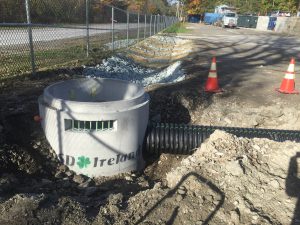The District helps area towns, businesses, and landowners understand the need for and implement green stormwater projects, or those that incorporate natural water cycle principles into urban water drainage systems. Examples of green stormwater projects include those that increase the infiltration of stormwater at the source, such as capturing water from impervious roofs or paved areas and infiltrating it into a nearby rain garden or a larger, engineered infiltration area.
Decreasing stormwater runoff can improve the water quality in nearby streams. Unfiltered water from rain events carries pollutants from the urban landscape and enters streams and lakes very quickly through the storm drain system, changing the hydrology of streams and increasing erosion. Studies have shown that small increases in impervious surfaces (effects are seen around 7% impervious surface area) can drastically change the hydrology of streams and negatively impact water quality. Application of Green Stormwater Infrastructure principles can help decrease these impacts.
To see more about PMNRCD and Stormwater Planning: Stormwater Planning.
Stormwater Master Plans identify sources of stormwater runoff, prioritize potential projects based on factors such as phosphorus contribution, and propose designs for high ranking projects.
Pawlet Village Stormwater Planning
PMNRCD, in coordination with the Village of Pawlet, identified multiple projects in the town center that may decrease the overland flow of water to Flower Brook during storm events. Stone Environmental is providing engineering expertise and is assisting the Village as they rank the identified projects for implementation. Most of the projects have received positive review from the residents and may be implemented if funding permits. Please contact us if you are interested in more information.
Castleton Watershed Stormwater Planning
In 2016, the District in conjunction with Fitzgerald Environmental Associates completed stormwater project identification activities in the Lake Bomoseen watershed. Residents near Crystal Beach reported large influxes of sediment at the mouth of Sucker Brook and the Lake Bomoseen Association was interested in identifying and mitigating the sources of sediment. Forty-eight projects were identified. Those projects are currently being revisited in hope that several may soon be implemented.
During 2017, the District, with assistance from Fitzgerald Environmental Associates, identified 74 projects through the Castleton Headwaters Stormwater Assessment. These projects are also being revisited in hope that grants available through the South Lake Clean Water Service Provider (CWSP) will fund project implementation around Lake Bomoseen and throughout the Castleton River Watershed.
Lake St Catherine and Wells Brook Stormwater Planning
PMNRCD completed the Lake St Catherine and Wells Brook Stormwater Master plan in 2019 with assistance from Fitzgerald Environmental Associates. The plan identified 50 high quality projects within the watershed and conceptual designs were developed for the top six projects. The top six projects were implemented in 2020 and 2021. During 2024 and 2025, ten more projects were prioritized for implementation and received conceptual designs. Work is ongoing to work with property owners and grant programs to implement these projects.
Spotlight
The Town of Castleton was awarded a $15,998 Clean Water Block Grant for stormwater management at the Castleton Transfer Station. The Castleton Transfer Station is one of the many projects identified during the Castleton Headwaters Stormwater Master Plan. The Town worked with Poultney Mettowee NRCD and Fitzgerald Environmental Associates for assistance procuring funding and with project design.
At the Castleton Transfer Station, stormwater runoff accumulates from the hill behind, driveway, and parking locations, causing ponding and erosion at and around the Transfer Station site. This area drains through a series of culverts to Pond Hill Brook.
Construction was finalized in 2018, with installation including a concrete pretreatment catch basin (in photo) providing 50 cubic feet of subsurface treatment for stormwater, a sediment forebay, and a dry swale with 900 cubic feet capacity. These infiltration and treatment practices address the runoff from a drainage area of over half an acre, most of which is comprised of impervious (or non-infiltrative) surfaces. Stormwater projects such as this help protect water quality while improving drainage at the project location.
